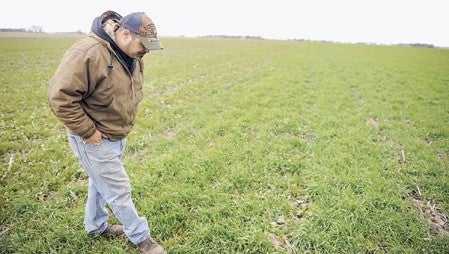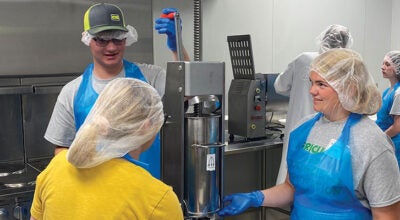Teaming up for soil health
Published 8:00 am Wednesday, April 13, 2016
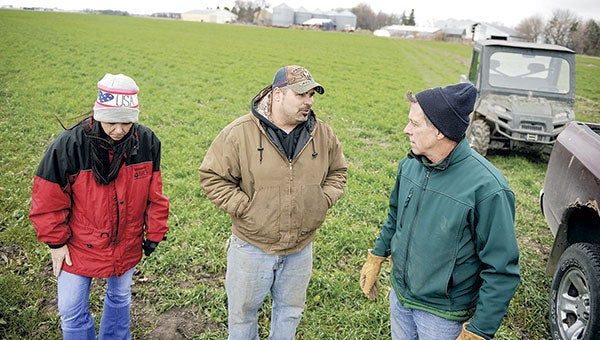
Landowner Tom Cotter, center, talks with Steve Lawler, resource specialist with the Mower County Soil and Water Conservation District and Andrea Horsman, a soil conversationalist with the Natural Resource Conservation Service about cover crops, which Cotter makes use of.
As Steve Lawler looked at winter cereal rye, tillage radish, annual rye and rapeseed growing as cover crops in Tom Cotter’s fields southwest of Austin and at the soil beneath last Friday, he liked what he saw.
“The soil looks really good, Tom,” said Lawler, a Mower County Soil & Water Conservation District resource socialist.
Though a brisk wind served as a reminder that the 2016 planting season is still weeks away, Cotter already has the cover crops planted. While the cover crops represent the promise of the upcoming season, they also represent new techniques and ideas farmers are exploring to promote soil health and improved farm practices.
Cover crops are at the center of an effort by Mower County and Fillmore County farmers to form a soil health team to try out practices like low-tillage farming in order to share their experiences with other producers.
“These are the people that are developing the answers to what are the best techniques to improve soil health,” Lawler said. “We wanted a reservoir of those farmers to be available to other farmers with similar questions.”
The team of about 11 farmers and agronomists is available to talk with other farmers who may be interested in cover crops or simply reducing how often they till their fields.
“The soil health is really being driven by producers,” Lawler said. “They’re trying to find their way through. They understand that there are things that are going in agriculture right now that are not going to necessarily be sustainable in the long run.”
But Andrea Horsman said government entities are largely absent from the process.
“We wanted to be driven by producers with government out of the picture, in the background,” said Horsman, a district conservationist with the Natural Resources Conservation Service (NRCS).
Cover crops are just one of many ways farmers are looking to address such ongoing concerns.
Cover crops
Cover crops are far from a new concept. In fact, Cotter says farmers in the area may be a bit behind farmers in the South, in Indiana and Illinois, and in Canada. If those farmers can do it, “We can do it down here,” Cotter said.
While there’s data on cover crops from other regions, Lawler said farmers want to know how it works here, because so much of farming is often dependent on weather and conditions.
“We all know it’s a benefit, it’s just about making it work,” Horsman said.
The soil health teams formed as a way way to help address concerns. Early in her work with cover crops, Horsman talked to her brother, a farmer and agronomist, about cover crops. He posed many questions about cover crops, and Horsman admitted many of her answers were, “I don’t know.” After learning from producers in Austin, she had the idea for a producer-driven team to help address such concerns.
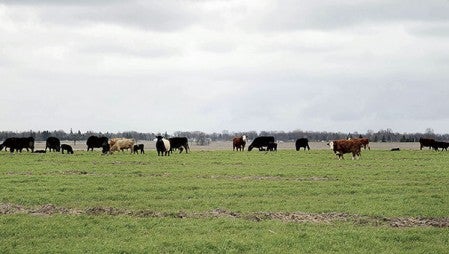
Cows graze in field belonging to Tom Cotter Friday morning. Instead of cement, his cattle can stand on a fields of cover crops.
How it works
The Cotters grow canning crops like peas and sweet corn, and they used to leave the fields bare during the winter. Many farmers are accustomed to tilling their fields in the spring and fall to keep weeds down and ready for the season. However, repeated tillages aren’t good for the soil.
A key idea behind cover crops is promoting minimal disturbances to the soil.
“Every tillage trip really should have a purpose,” Cotter said.
Each tillage disturbs the biological makeup of the soil, Lawler said, meaning the soil then needs to rebuild itself.
“We’re trying to minimize the time the soil needs to rebuild itself by just less disturbance,” he said.
Cover crops are typically planted in the fall to emerge before winter sets in; Cotter planted cover crops through about Nov. 10 last year. The cover crops continue growing in spring before they’re terminated with chemical before the planting.
Cotter does some strip tilling in the fields to ready for the planting, but he will go in and just plant his beans right through the cover crop, though he admits that can be scary.
Once the cover crop is terminated, Cotter will wait about seven days before planting corn. For soybeans, he’ll plant a day before, the day of or a day after terminating the cover crop.
The cover crop isn’t harvested, instead the terminated cover crop is incorporated as a green manure and almost as a protective layer for the soils.
Benefits
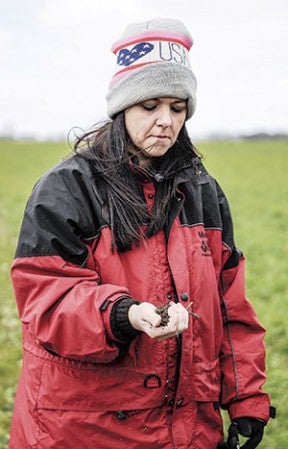
Andrea Horseman, a soil conservationist with the Natural Resources Conservation Service examines soil from a field belonging to Tom Cotter.
Cover crops have several benefits with the key goal being to promote healthier soil. Cotter noted some heavily tilled, worked fields have soil with little smell or a dead smell. But fields with cover crops often smell healthier, almost like a cup of coffee, according to Cotter.
“You get in, that’s rich,” Cotter said. “I can smell it and you can find the earthworms.”
The cover crops also promote healthy organic activity and things like earthworms. Studies in Illinois have shown cover crops produce more organic carbon stock than traditional soils.
Cover crops are also vital when it comes to water. Cover crops improve infiltration rates for soils and reduce runoff. So instead of water hitting bare soil, disrupting that soil and running off before it can infiltrate the soil, the remaining organic material from the dead cover crops helps absorb moisture into the soil.
“We’ve found that soils under intense agricultural production tend to destabilize under the forces of the rain drops and scatter, and that’s when you get erosion,” Lawler said. “Whereas under cover crops, the soil tends to develop itself into aggregates that hold together and resist those forces.”
Cotter talked about seeing a rainfall simulator that showed how this works, with traditional field seeing the soil run off and a cover cropped, low-tilled field seeing the water seep into the soil. SWCD officials plan to demonstrate that system this summer.
Though Cotter uses chemical to terminate cover crops, he typically has to use fewer chemicals during the season for weed control, so he admits there’s a give and take.
Last year, Cotter used fewer passes of weed control and had good beans, but he said every year is different.
“Every year is different, so you can’t really just say it’s always going to be like that,” Cotter said.
Horsman said weather is usually the ultimate factor.
Challenges and risks
Yet cover crops are a bit of a risk, and Cotter and Horsma say there are really no experts on it in the area.
“There are so many things that you have to think about when it comes to planting the cover crop: the short growing season, you’ve got to think abut all the chemicals you’re putting down, what to plant, what works out best — there’s a lot,” Horsman said.
Along with the challenges and risks of needing the cover crop to grow to a preferable level before being knocking down, Horsman admits Mother Nature often plays a key role.
Another challenge with cover crops, according to Lawler, is planting them early enough in the fall to get emergence before winter sets in.
Cotter and his father, Michael, tried cover crops about 12 years ago, but they did it without necessarily knowing how to handle or control it at the time.
One goal of the soil health team is to address issues like Cotter’s initial fears. Before, he admits he had no one to go to with questions, aside from the Internet. It’s much nicer, he said, to call another farmer from the area for advice and general discussion.
Michael admitted he was scared when his son went to plant through the knocked-down cover crops last year. Cotter felt some trepidation as well, as he admitted he kept a book of his cover cropping process, but he skipped following the planting process.
“The only thing I don’t have in there is the pictures of me planting because when I did I was too scared, too nervous too — thought I was going crazy — thinking, ‘OK, how much is new seed going to cost to replant this whole field?’” Cotter said. “And I didn’t have to. It all came. I even upped my population.”
Quantifying the benefits
Despite some risks, early returns from farmers like Cotter have been positive, and Lawler was impressed with the condition of Cotter’s soil last week.
“The bottom line is these producers are seeing benefits … and they’re going to keep at it,” Lawler said. “And they’re going to work out the kinks in it.”
While members of the soil health team are seeing benefits thus far, farmers want more than just the word of other farmers — they want data.
“They want to see the data and that’s what we’re trying to provide them,” Horsman said.
That’s where the NRCS and SWCD come in. The groups joined the team with the goal of quantifying and collecting data on cover crops and how these methods are affecting soil health. The SWCD is forming data plots throughout the county, and they’re doing temperature studies now and will do other studies to answer questions and determine the benefits.
“The farmers want the numbers and they want the numbers derived locally,” Lawler said. “They don’t want Indiana or Illinois, they want numbers from Minnesota on what this is doing to their soils.”
The SWCD and NRCS will go back to these plots after a few year to track biological and physical changes.
The 11 members of the soil health team are available for other farmers to contact to discuss ideas. While people like Cotter are available to help, he admits he and other team members learn from the producers who call them too.


